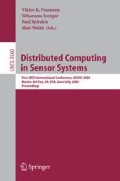Abstract
Implanted biological sensors are a special class of wireless sensor networks that are used in-vivo for various medical applications. One of the major challenges of continuous in-vivo sensing is the heat generated by the implanted sensors due to communication radiation and circuitry power consumption. This paper addresses the issues of routing in implanted sensor networks. We propose a thermal-aware routing protocol that routes the data away from high temperature areas (hot spots). With this protocol each node estimates temperature change of its neighbors and routes packets around the hot spot area by a withdraw strategy. The proposed protocol can achieve a better balance of temperature rise and only experience a modest increased delay compared with shortest hop, but thermal-awareness also indicates the capability of load balance, which leads to less packet loss in high load situations.
This work is supported in part by NSF grants ANI-0086020.
Access this chapter
Tax calculation will be finalised at checkout
Purchases are for personal use only
Preview
Unable to display preview. Download preview PDF.
References
Schwiebert, L., Gupta, S.K.S., Auner, P.S.G., Abrams, G., Lezzi, R., McAllister, P.: A biomedical smart sensor for visually impaired. In: IEEE Sensors 2002, Orlando, FL, USA (2002)
Tang, Q., Tummala, N., Gupta, S.K.S., Schwiebert, L.: Communication scheduling to minimize thermal effects of implanted biosensor networks in homogeneous tissue. IEEE Tran. Biomedical Eng. (accepted for publication)
Hirata, A., Ushio, G., Shiozawa, T.: Calculation of temperature rises in the human eye for exposure to EM waves in the ISM frequency bands. IEICE Trans. Comm. E83-B, 541–548 (2000)
International Electrotechnical Commission IEC: Medical Electrical Equipment, Part 2-33: Particular Requirement for the Safety of Magnetic Resonance Systems for Medical Diagnosis IEC 60601-2-33. 2nd edn. (1995)
Pennes, H.H.: Analysis of tissue and arterial blood temperature in the resting human forearm. Journal of Applied Physiology 1.1, 93–122 (1948)
Heinzelman, W.R., Chandrakasan, A., Balakrishnan, H.: Energy-efficient communication protocol for wireless microsensor networks. In: Proc. 33rd Hawaii Int’l Conf. System Sciences, vol. 8, p. 8020. IEEE Computer Society, Los Alamitos (2000)
Ding, W., Iyengar, S.S., Kannan, R., Rummler, W.: Energy equivalence routing in wireless sensor networks. Journal of Microcomputers and Applications: Special issue on Wireless Sensor Networks (2004)
Woo, A., Tong, T., Culler, D.: Taming the underlying challenges of reliable multihop routing in sensor networks. In: SenSys 2003, pp. 14–27. ACM Press, New York (2003)
Estrin, D., Michener, W., Bonito, G.: Environmental cyberinfrastructure needs for distributed sensor networks. In: A report from a national science foundation sponsored workshop (2003)
Tseng, F.G., Ho, C.E., Chen, M.H., Hung, K.Y., Su, C.J., Chen, Y.F., Huang, H.M., Chieng, C.C.: A chip-based-instant protein micro array formation and detection system. In: Proc. of NSTI Naotech 2004, Boston, vol. 1, pp. 39–42 (2004)
Prakash, Y., Lalwani, S., Gupta, S.K.S., Elsharawy, E., Schwiebert, L.: Towards a propagation model for wireless biomedical applications. In: IEEE ICC 2003, vol. 3, pp. 1993–1997 (2003)
National Council on Radiation and Measurements: A Practical Guide to the Determination of Human Exposure to Radio Frequency Fields. Report no. 119. NCRP, Bethseda, MD (1993)
Ulaby, F.T.: Fundamentals of Applied Electromagnetics. Prentice Hall, Englewood Cliffs (1999)
Sullivan, D.M.: Electromagnetic Simulation Using the FDTD Method. IEEE Press, Los Alamitos (2000)
Ganesan, D., Govindan, R., Shenker, S., Estrin, D.: Highly-resilient, energy-efficient multipath routing in wireless sensor networks. SIGMOBILE Mob. Comput. Commun. Rev. 5, 11–25 (2001)
Author information
Authors and Affiliations
Editor information
Editors and Affiliations
Rights and permissions
Copyright information
© 2005 Springer-Verlag Berlin Heidelberg
About this paper
Cite this paper
Tang, Q., Tummala, N., Gupta, S.K.S., Schwiebert, L. (2005). TARA: Thermal-Aware Routing Algorithm for Implanted Sensor Networks. In: Prasanna, V.K., Iyengar, S.S., Spirakis, P.G., Welsh, M. (eds) Distributed Computing in Sensor Systems. DCOSS 2005. Lecture Notes in Computer Science, vol 3560. Springer, Berlin, Heidelberg. https://doi.org/10.1007/11502593_17
Download citation
DOI: https://doi.org/10.1007/11502593_17
Publisher Name: Springer, Berlin, Heidelberg
Print ISBN: 978-3-540-26422-4
Online ISBN: 978-3-540-31671-8
eBook Packages: Computer ScienceComputer Science (R0)

